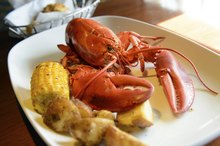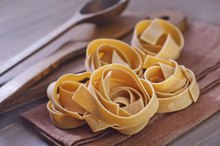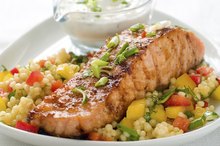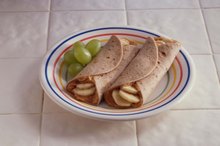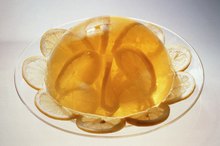What does fact checked mean?
At Healthfully, we strive to deliver objective content that is accurate and up-to-date. Our team periodically reviews articles in order to ensure content quality. The sources cited below consist of evidence from peer-reviewed journals, prominent medical organizations, academic associations, and government data.
- National Institute of Arthritis and Musculoskeletal and Skin Diseases: What is Gout?
- MayoClinic.com: Gout Diet
The information contained on this site is for informational purposes only, and should not be used as a substitute for the advice of a professional health care provider. Please check with the appropriate physician regarding health questions and concerns. Although we strive to deliver accurate and up-to-date information, no guarantee to that effect is made.
Gout, a painful form of arthritis, results from excess uric acid levels in the body. Uric acid crystal deposits develop in the joints, leading to pain, swelling, redness and joint stiffness. Kidney problems may occur because of kidney stones formed from uric acid crystals in the kidneys. A diet for gout prevention or alleviation may help control the development of and eliminate uric acid to relieve or prevent gout attacks. Dairy products, including buttermilk, play a part in the diet to reduce the risk of gout. Check with your doctor for dietary advice related to gout.
If you are experiencing serious medical symptoms, seek emergency treatment immediately.
Uric Acid Overproduction
Substances called purines are found in your body’s tissues and also come from many foods. Purines break down into uric acid in your body and usually dissolve in the blood, passing through the kidneys and out of your body through urine. Gout may occur when your body produces too much uric acid, your kidneys don't get rid of enough uric acid or you eat too many foods high in purines, according to the National Institute of Arthritis and Musculoskeletal and Skin Diseases 1.
Avoidance of Purines
List of Foods High in Uric Acid
Learn More
Medication helps relieve and reduce gout symptoms, and a diet consisting of foods low in purines may control gout attacks. Low purine intake includes limiting meat, poultry and fish, which contain high amounts of purine, MayoClinic.com explains 2. Foods particularly high in purines include organ meats, asparagus, mushrooms, anchovies and herring. Gout patients also need to avoid alcohol, which can interfere with the body’s ability to eliminate uric acid.
- Medication helps relieve and reduce gout symptoms, and a diet consisting of foods low in purines may control gout attacks.
Foods Low in Purines
Drinking plenty of fluids, especially water, helps remove uric acid from your body.
Buttermilk Reduces Risk
What Causes Gout and Bursitis?
Learn More
Buttermilk has a lower fat content than regular milk. The process of making buttermilk removes the fat to make butter. Low-fat and nonfat milk and dairy products, including buttermilk and low-fat yogurt, may help reduce the risk of gout. MayoClinic.com recommends 16 to 24 fluid ounces of dairy intake daily for gout 2. Buttermilk is also a probiotic food. Probiotics contain healthy bacteria that fight harmful bacteria in your body. The probiotics in buttermilk help improve digestion.
- Buttermilk has a lower fat content than regular milk.
More Buttermilk Benefits
Because buttermilk has low-fat content, it helps you maintain a healthy weight. Being overweight or obese may increase your risk of gout. Moderate daily exercise, such as brisk walking, along with a low-fat diet, works to reduce weight. Maintaining a healthy weight through a diet that includes buttermilk, and avoiding alcohol, also helps you deal more effectively with stress. Stressful events may trigger gout attacks.
- Because buttermilk has low-fat content, it helps you maintain a healthy weight.
- Maintaining a healthy weight through a diet that includes buttermilk, and avoiding alcohol, also helps you deal more effectively with stress.
Related Articles
References
- National Institute of Arthritis and Musculoskeletal and Skin Diseases: What is Gout?
- MayoClinic.com: Gout Diet
- NutriHealth: Why Drink Buttermilk
- National Institute of Arthritis and Musculoskeletal and Skin Diseases. Gout. Updated April 2016.
- Zhang Y, Chen C, Choi H, et al. Purine-rich foods intake and recurrent gout attacks. Ann Rheum Dis. 2012; 71(9):1448-53. doi:10.1136/annrheumdis-2011-201215
- Fischer E. Ueber die Harnsauer. 1 [On Uric Acid. 1]. Berichte der Deutschen Chemischen Gesellschaft. 1884: 17:328-338. doi:10.1002/cber.18980310304
- Ragab, G., Elshahaly, M., & Bardin, T. (2017). Gout: An old disease in new perspective – A review. Journal of Advanced Research, 8(5), 495–511. doi:10.1016/j.jare.2017.04.008
- Centers for Disease Control and Prevention. Gout. Updated January 28, 2019.
- Zgaga, L., Theodoratou, E., Kyle, J., Farrington, S. M., Agakov, F., Tenesa, A., … Campbell, H. (2012). The Association of Dietary Intake of Purine-Rich Vegetables, Sugar-Sweetened Beverages and Dairy with Plasma Urate, in a Cross-Sectional Study. PLoS ONE, 7(6), e38123. doi:10.1371/journal.pone.0038123
- Choi HK, Gao X, Curhan G. Vitamin C intake and the risk of gout in men: a prospective study. Arch Intern Med. 2009;169(5):502–507. doi:10.1001/archinternmed.2008.606
- Zhang Y, Neogi T, Chen C, Chaisson C, Hunter DJ, Choi HK. Cherry consumption and decreased risk of recurrent gout attacks. Arthritis Rheum. 2012;64(12):4004–4011. doi:10.1002/art.34677
- Arthritis Foundation. Gout Diet: Dos and Don’ts.
- Boban M, Modun D. Uric acid and antioxidant effects of wine. Croat Med J. 2010;51(1):16–22. doi:10.3325/cmj.2010.51.16
- Caliceti C, Calabria D, Roda A, Cicero AFG. Fructose Intake, Serum Uric Acid, and Cardiometabolic Disorders: A Critical Review. Nutrients. 2017;9(4):395. Published 2017 Apr 18. doi:10.3390/nu9040395
- U.S. Department of Health and Human Services and U.S. Department of Agriculture. 2015–2020 Dietary Guidelines for Americans. 8th Edition. Published December 2015.
- U.S. Department of Health and Human Services. Gripped by Gout. NIH News in Health. Published February 2014.
- Kakutani-Hatayama M, Kadoya M, Okazaki H, et al. Nonpharmacological Management of Gout and Hyperuricemia: Hints for Better Lifestyle. Am J Lifestyle Med. 2015;11(4):321–329. Published 2015 Sep 2. doi:10.1177/1559827615601973
Writer Bio
Jerry Shaw writes for Spice Marketing and LinkBlaze Marketing. His articles have appeared in Gannett and American Media Inc. publications. He is the author of "The Complete Guide to Trust and Estate Management" from Atlantic Publishing.
